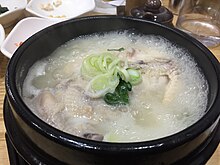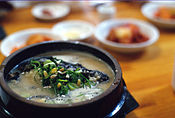Samgye-tang
 | |
| Alternative names | Ginseng chicken soup |
|---|---|
| Type | Tang |
| Place of origin | Korea |
| Serving temperature | Hot or Warm |
| Main ingredients | Chicken, ginseng |
| Ingredients generally used | Jujube, glutinous rice |
| Korean name | |
| Hangul | 삼계탕 |
|---|---|
| Hanja | 蔘鷄湯 |
| Revised Romanization | samgye-tang[1][2] |
| McCune–Reischauer | samgye-t'ang |
| IPA | [sam.ɡje̞.tʰaŋ] |
Samgye-tang (삼계탕; 蔘鷄湯) or ginseng chicken soup,[1] meaning ginseng (Kor. sam) - chicken (Kor. gye) - soup (Kor. tang) in Korean, consists primarily of a whole young chicken (poussin) filled with garlic, rice, jujube, and ginseng.[3] Samgye-tang is a Korean traditional soup for body health.[4] Samgye-tang is a representative summer health food. Soup made with chicken that is slightly larger than the chick is called Yeonggye Baeksuk, and the chicken is divided into half is called Banggye-tang.

History[]
The history of Samgye-tang is not long, and the culture of eating Samgye-tang on Bok Days seems to have been settled since the 1960s. The original version of Samgye-tang was found during the Joseon Dynasty. In particular, it was one of the most common meat dishes used in the days when meat was scarce.
Samgye-tang began in the Japanese colonial era period in Korea when many rich families made it with white ginseng powder in chicken soup or chicken soup, which was sold in restaurants in the late 1940s, and settled as a separate dish called Gyesam-tang around the 1950s. At first, ginseng powder was used, but after the 1960s, the distribution of refrigerators enabled the long-term preservation of ginseng, which changed to dried ginseng. It was not until the 1960s that the current Samgye-tang was called.[5]
Originally, Samgye-tang was called Gyesam-tang, not Samgye-tang. This implied that chicken is more important than ginseng to give the impression that that chicken was beneficial for the health. Samgye-tang, on the contrary, suggests a grater importance of the ginseng.[6]
Custom[]
Samgye-tang is a warm soup for hot summer days for its supposed beneficial nutrients which are supposed to replace the nutrients lost through excessive sweating and physical activity.[7] It is especially popular to eat this chicken soup on sambok (삼복) days, which are three distinct days of the lunar calendar—Chobok (초복), Jungbok (중복), and Malbok (말복)—commonly among the hottest and most sultry summer days in Korea.[3][8]
Some specialty restaurants in South Korea serve only samgyetang, having gained local popularity through their special recipes for the dish, which are often kept as secrets. The dish is sometimes accompanied by a small complimentary bottle of insam-ju (ginseng wine) in certain restaurants.[9][10]
Recipe[]
The recipe for Samgye-tang is to put glutinous rice, garlic and jujube wrapped in clean cloth in the stomach of the gutted chicken, and boil it in a pot with plenty of water to get it out when the meat is fully cooked. Ginseng is wrapped in a cloth, put in soup, and the ingredients of ginseng are thickened, so it is seasoned with salt to drink only the soup, or seasoned meat in the soup. However, if ginseng is mixed with glutinous rice and put into a chicken, the nutrients of ginseng permeate the chicken bones, reducing the nutrients of ginseng. In addition to ginseng, it is also eaten with poison ivy, cedar, and abalone. Some say that jujube should not be eaten because it absorbs the bad ingredients of Samgye-tang, but it is not true and can be eaten.[11]
Although it is considered standard to add young chicken and ginseng for 6 years as ingredients in Samgye-tang, many restaurants do not find these ingredients easily and often use Ungchu or 4-year-old ginseng because the cost of ingredients becomes more expensive. In fact, there is an opinion that four-year-old ginseng has no problem because saponin, the effective ingredient of ginseng, is not much different from six-year-old ginseng. Some companies use ginseng for one to two years or replace it with Astragalus propinquus that tastes similar.[12]
Gallery[]

Samgye-tang (closeup)

Samgyetang

Samgyetang

Ogolgye samgyetang
See also[]
| Wikimedia Commons has media related to Samgyetang. |
References[]
- ^ Jump up to: a b (in Korean) "주요 한식명(200개) 로마자 표기 및 번역(영, 중, 일) 표준안" [Standardized Romanizations and Translations (English, Chinese, and Japanese) of (200) Major Korean Dishes] (PDF). National Institute of Korean Language. 2014-07-30. Retrieved 2017-02-16. Lay summary.
- ^ "삼계탕". National Institute of Korean Language. Retrieved 2018-02-13.
- ^ Jump up to: a b Hyosun Ro. "Samgyetang (Ginseng Chicken Soup)". Korean Bapsang. Retrieved 2014-12-25.
- ^ (in Korean) "삼계탕[samgyetang / Ginseng Chicken Soup,蔘鷄湯]". doopedia. Retrieved 2021-03-30.
- ^ "계삼탕(鷄蔘湯) - 한국민족문화대백과사전". encykorea.aks.ac.kr. Retrieved 2021-06-06.
- ^ 수정: 2018.07.16 13:00, 입력: 2018 07 16 09:30 (2018-07-16). "삼계탕의 원래 이름은 '계삼탕'···삼계탕은 왜 복날 먹을까?". news.khan.co.kr (in Korean). Retrieved 2021-06-06.
- ^ Lim, Tong Kwee (2015). Edible medicinal and non medicinal plants. Volume 9, Modified stems, roots, bulbs. Dordrecht. p. 511. ISBN 978-94-017-9511-1. OCLC 897810272.
- ^ (in Korean) Boknal Archived 2011-06-10 at the Wayback Machine at Encyclopedia of Korean Culture
- ^ (in Korean) Taste, this taste, Sports Khan, 2009-06-08. Retrieved 2010-07-06.
- ^ (in Korean) Nutritious foods of summer and wine, Maekyung, 2009-07-07.Retrieved 2010-07-06.
- ^ ""삼계탕 속 대추, 먹으면 안 돼"...진실은?". www.ytn.co.kr (in Korean). 2016-07-17. Retrieved 2021-06-06.
- ^ Sue (2017-07-08). "Samgyetang (Korean Ginseng Chicken Soup)". My Korean Kitchen. Retrieved 2021-06-06.
External links[]
- Kim Yeong-bok (김영복) / Yeo Gyeong-mo (여경모) (2007-07-12). "Samgyetang Story 1 (삼계탕 이야기 (상))" (in Korean). idomin.com.
- Kim Yeong-bok (김영복) / Yeo Gyeong-mo (여경모) (2007-07-26). "Samgyetang Story 2 (삼계탕 이야기 (하))" (in Korean). idomin.com.
- Korean chicken dishes
- Korean soups and stews
- Chicken soups





